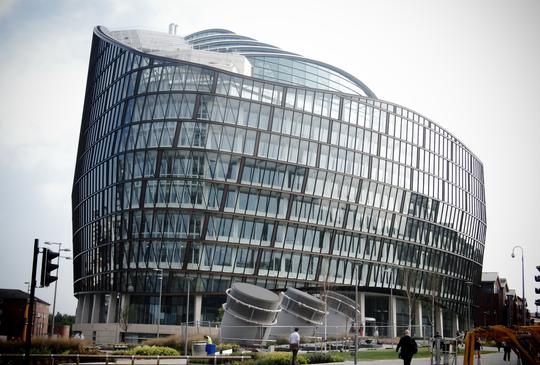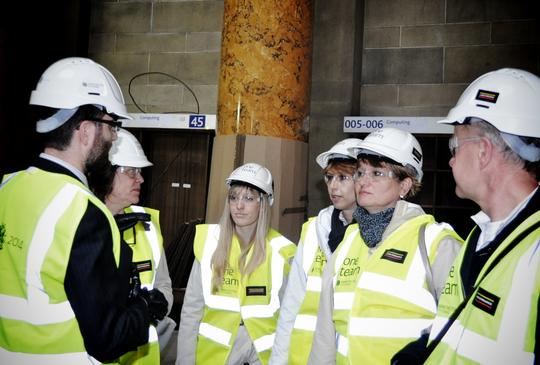
A tale of two (low carbon) buildings
One, the Co-operative Group’s new £100 million head office at One Angel Square, is a state-of-the-art paean to sustainability, the other, the much-loved Town Hall Extension, an example of how old buildings can be made fit for purpose.
Town Hall refurb
The Extension was opened in 1935 and its recent refurbishment is part of a five year, £154 million project that is taking in two of the city’s other great landmarks, the Central Reference Library and St Peter’s Square, too.
But as well as bringing the building up to 21st century standards of sustainability, new life also been breathed into the offices, with the council closing nine of its other sites and re-locating the staff to the extension.
This left the developers Laing O'Rourke and the architecture team at BDP with something of a conundrum – on the one hand they had to make the building more energy efficient and sustainable, yet on the other they had to remove all the old office partitions to create an open plan office to house around 700 more people, with more floor space requiring extra heating, lighting and ventilation.
Another issue was the building’s grade II* listed status. A key objective of the refurbishment was that the building should be able to meet 20% of its own energy need from renewable resources, but solar panels and wind turbines were both inappropriate.
Instead, at the core of the building is a new Combined Cooling, Heating and Power (CCHP) system. Powered by natural gas, and classed as a low carbon technology, it’s running costs are so low it’s estimated that it will have paid for itself in just nine years.
The building’s windows, many of which had been painted shut for decades, also posed a problem. Replacing them with new double or secondary glazing was not acceptable to English Heritage, while pay back times were also prohibitive, so the bronze and brass frames were refurbished, which means staff can once again control ventilation in the building.
English Heritage did allow the developers to replace many of the old, inefficient lights with new fittings and, where possible, LED too, and along with the latest energy efficient white goods and PCs, there was also a major push to introduce fibre cabling throughout the building.
As well as being quicker than copper, it helped reduced the concentration of IT hubs which in turn meant less energy-intensive chilling, while the remaining hubs are cooled from the chilled water from the absorption chiller, itself part of the CCHP system. Ultimately, it’s hoped that work will lead to a 35% reduction in the building’s energy bill.
Outstandingly sustainable
Across the city, and a vey different development has taken shape.
One Angel Square is the new £100 million home of the Co-operative Group, a futuristic structure that has taken commercial sustainability to a new level. Described as the most sustainable large office building in Europe, it has already received the construction industry’s top environmental rating – BREEAM outstanding.
The building has been designed to use half the energy of the former head office and produce 80 per cent less carbon, leading to a reduction in operating costs of up to a third.
Fifty thousand litres of fresh air are sucked in to the building every second via three large earth tubes in front of the offices. They draw fresh air underground, where it is heated or cooled to the earth’s ambient temperature (around 18 degrees) and then redistributed throughout the building, cutting out the need for heating and air conditioning.

The building also has a double skin façade which acts as a ‘duvet’, insulating the building in the winter and allowing ventilation in the summer, while a special coating on the glass helps to minimise solar glare.
The offices are powered by a combined heating and power system (CHP) which runs on rapeseed oil grown on The Co-op’s own farms, which means the building never draws from the national grid but can feed power back. Any waste heat from the boiler provides cooling via absorption chillers and chilled beams, while recovered heat from both the atrium and the low energy IT system is used to heat the building. There is also extensive grey and rain water recycling.
As with Town Hall Extension, One Angel Square is part of a bigger project, NOMA, an £800 million project that will transform 20 acres of Manchester’s city centre heartland into a mixed-use development.

Both buildings formed part of a tour during a visit by members of the pan-European Regions for Growth team earlier this month. Delegates were able to see at first hand how two very different buildings, built at two very different times, are now both beacons of Manchester’s low carbon future.
Contributor Profile
Mark Hillsdon is a freelance writer with a passion for nature and the great outdoors. A regular contributor to magazines such as Coast and CountryFile, he also writes on sustainability for the Guardian, and the occasional travel piece for the Independent. On Sunday. He has also been writing on all things Mancunian since first getting off the Euston train as a student nearly 30 years ago.

